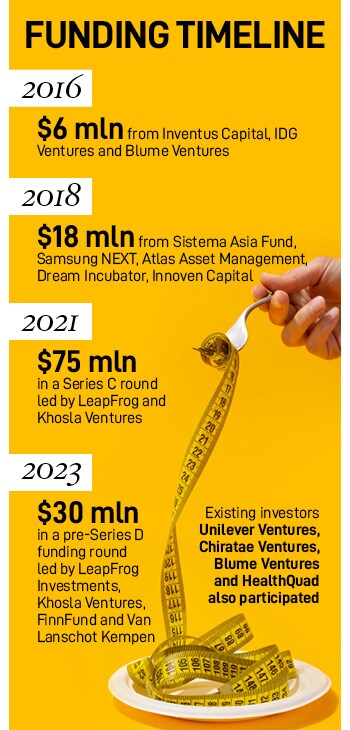
Can HealthifyMe burn calories in a profitable way?
Rebuffs from VCs, snubs from doctors, and pressure to prove naysayers wrong. It was hard for Tushar Vashisht to keep his digital health and wellness company in shape for the first seven years. Then, AI came along
 Tushar Vashisht, co-founder and CEO, HealthifyMe; Image Courtesy: HealthifyMe
Tushar Vashisht, co-founder and CEO, HealthifyMe; Image Courtesy: HealthifyMe
July 2014, Bengaluru
The ‘Iron Man’ had burnt all his calories. “We have run out of money. I can’t pay salaries,” lamented Tushar Vashisht, who broke the news to his 20-member crew on a drizzly July afternoon. Co-founded by Vashisht and Mathew Cherian in 2011, digital health and wellness startup HealthifyMe had raised a crore in angel money in 2012, and two years later, the runway had come to an abrupt end. “You are free to leave, but I will be here tomorrow morning, raring to face another day…” announced the co-founder and CEO. The first-generation founder, who had gained over two dozen kilos once he came back to India in 2010, was confronted with a grim reality: All his startup had gained was empty calories.
HealthifyMe lacked muscle. The three-year old venture, which had started from a farmhouse in Delhi with a mission to help people count calories, track food and lead healthier lives, had failed to keep a track of its own financial health. To be fair to the rookie founders, the first year was spent in looking for evangelists who could believe in the vision of calorie counting and food tracking. “Who better than doctors and hospitals,” the enterprising duo had said to themselves.
There was one small problem, though. The doctors were sceptical, and the hospitals couldn't make sense of their hour-long passionate pitches. “Our ideas seemed to be ahead of their time,” recalls Vashisht, who booked paid consultations with hundreds of diabetologists just to get their time. In fact, he even came up with the idea of ‘urinator pitch’—pitching an idea to a senior diabetologist in the toilet. But nothing worked. Now, in July 2014, HealthifyMe didn’t have many options. “We almost died,” recalls Vashisht, a University of Pennsylvania graduate, who began his professional innings in 2007 with Deutsche Bank in the US, then shifted to Singapore and was done with his banking gig towards the beginning of 2010.






 Now, in 2014, HealthifyMe founders neither had Rs100 nor Rs32 to buy carbohydrate, protein or run their venture, which had exhausted Rs1 crore of angel money. With zero calories and zero money, a beleaguered Vashisht tried to lift the morale of his team. “Some companies exist because they can. Others get lucky. Yet others defy all odds and exist even when there is no reason to exist,” he underlined in an email sent to employees. “We fall in the latter,” Vashisht reiterated.
Now, in 2014, HealthifyMe founders neither had Rs100 nor Rs32 to buy carbohydrate, protein or run their venture, which had exhausted Rs1 crore of angel money. With zero calories and zero money, a beleaguered Vashisht tried to lift the morale of his team. “Some companies exist because they can. Others get lucky. Yet others defy all odds and exist even when there is no reason to exist,” he underlined in an email sent to employees. “We fall in the latter,” Vashisht reiterated. Enter Ria. In October 2017, HealthifyMe rolled out Ria, an AI-enabled nutritionist. Ria, points out Vashisht, would use learnings amassed from over 150 million tracked meals, and 10 million message exchanges between coaches and clients. The AI nutritionist was equipped to answer questions around nutrition and fitness in over 10 languages and could provide personalised responses based on users' lifestyle habits. But what Ria did was much more than Q&A, explains Vashisht. Ria identified not-so-healthy foods such as vegetarian mayo sandwich, kachoris, samosas, rolls, ketchup, croissants, frankies, pakoras, and then suggested healthy replacements like roasted kala chana, tomato soup, besan cheela, veg poriyal, veg dalia, curd, oats, flaxseeds and rava upma.
Enter Ria. In October 2017, HealthifyMe rolled out Ria, an AI-enabled nutritionist. Ria, points out Vashisht, would use learnings amassed from over 150 million tracked meals, and 10 million message exchanges between coaches and clients. The AI nutritionist was equipped to answer questions around nutrition and fitness in over 10 languages and could provide personalised responses based on users' lifestyle habits. But what Ria did was much more than Q&A, explains Vashisht. Ria identified not-so-healthy foods such as vegetarian mayo sandwich, kachoris, samosas, rolls, ketchup, croissants, frankies, pakoras, and then suggested healthy replacements like roasted kala chana, tomato soup, besan cheela, veg poriyal, veg dalia, curd, oats, flaxseeds and rava upma. Revenues have leapfrogged from Rs86.05 crore in FY21 to Rs185.25 crore in FY22. The startup claims to have over 35 million users, 1,000+ coaches and a presence in 300 cities in India and abroad. In fact, 20 percent of revenue comes from outside India. “I have been tracking HealthifyMe for a few years now. What they have achieved in India with their AI coaching solution at scale is truly pioneering for the world,” reckons Vinod Khosla, founding partner at Khosla Ventures. “We are excited about the potential as they scale globally, specifically in North America, where two out three adults are overweight or obese,” he adds.
Revenues have leapfrogged from Rs86.05 crore in FY21 to Rs185.25 crore in FY22. The startup claims to have over 35 million users, 1,000+ coaches and a presence in 300 cities in India and abroad. In fact, 20 percent of revenue comes from outside India. “I have been tracking HealthifyMe for a few years now. What they have achieved in India with their AI coaching solution at scale is truly pioneering for the world,” reckons Vinod Khosla, founding partner at Khosla Ventures. “We are excited about the potential as they scale globally, specifically in North America, where two out three adults are overweight or obese,” he adds.




